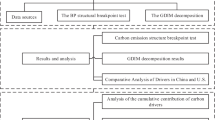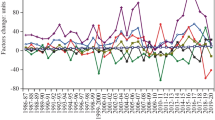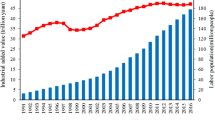Abstract
In order to investigate the main drivers of CO2 emissions changes in China during the 11th Five-Year Plan period (2006–2010) and seek the main ways to reduce CO2 emissions, we decompose the changes of energy-related CO2 emissions using the production-theoretical decomposition analysis approach. The results indicate that, first, economic growth and energy consumption are the two main drivers of CO2 emissions increase during the sample period; particularly in the northern coastal, northwest and central regions, where tremendous coal resources are consumed, the driving effect of their energy consumption on CO2 emissions appears fairly evident. Second, the improvement of carbon abatement technology and the reduction in energy intensity play significant roles in curbing carbon emissions, and comparatively the effect of carbon abatement technology proves more significant. Third, energy use technical efficiency, energy use technology and carbon abatement technical efficiency have only slight influence on CO2 emissions overall. In the end, we put forward some policy recommendations for China’s government to reduce CO2 emissions intensity in the future.

Similar content being viewed by others
Notes
Due to data availability, this paper does not cover the data of Tibet.
References
Ang BW (1999) Is the energy intensity a less useful indicator than the carbon factor in the study of climate change? Energy Policy 27:943–946
Ang BW (2004) Decomposition analysis for policymaking in energy: which is the preferred method? Energy Policy 32:1131–1139
Ang BW, Pandiyan G (1997) Decomposition of energy-induced CO2 emissions in manufacturing. Energy Economics 19:363–374
Ang BW, Zhang FQ (2000) A survey of index decomposition on analysis in energy and environmental studies. Energy 25:1149–1176
Ang BW, Liu FL, Chew EP (2003) Perfect decomposition techniques in energy and environmental analysis. Energy Policy 31:1561–1566
Caves DW, Christensen LR, Diewert WE (1982) Multilateral comparisons of output, input and productivity using superlative index numbers. Econ J 92:73–86
Chang YF, Lewis C, Lin SJ (2008) Comprehensive evaluation of industrial CO2 emission (1989–2004) in Taiwan by input–output structural decomposition. Energy Policy 36:2471–2480
ERI (Energy Research Institute, National Development and Reform Commission) (2003) China sustainable energy and carbon emissions scenario analysis comprehensive report
Färe R, Grosskopf S, Norris M, Zhang Z (1994) Productivity growth, technical progress and efficiency change in industrialized countries. American Economic Review 84:66–83
Freitas LC, Kaneko S (2011) Decomposition of CO2 emissions change from energy consumption in Brazil: challenges and policy implications. Energy Policy 39:1495–1504
Hatzigeorgiou E, Polatidis H, Haralambopoulos D (2008) CO2 emissions in Greece for 1990–2002: a decomposition analysis and comparison of results using the arithmetic mean Divisia Index and logarithmic mean Divisia Index techniques. Energy 33:492–499
IPCC (Intergovernmental Panel on Climate Change) (2006) IPCC guidelines for national greenhouse gas inventories
Li M (2010) Decomposing the change of CO2 emissions in China: a distance function approach. Ecol Econ 70:77–85
Li HN, Mu HL, Zhang M, Gui SS (2012) Analysis of regional difference on impact factors of China’s energy-related CO2 emissions. Energy 39:319–326
Meng L, Guo JE, Chai J, Zhang ZK (2011) China’s regional CO2 emissions: characteristics inter-regional transfer and emission reduction policies. Energy Policy 39:6136–6144
NBSC (National Bureau of Statistics of China) (2011) China statistical yearbook. China Statistics Press, Beijing
NBSC (National Bureau of Statistics of China), NDRC (National Development and Reform Commission) (2011) China energy statistical yearbook. China Statistics Press, Beijing
Paul S, Bhattacharya RH (2004) CO2 emission from energy use in India: a decomposition analysis. Energy Policy 32:585–593
Sun JW (1998) Changes in energy consumption and energy intensity: a complete decomposition model. Energy Economics 20:85–100
Wang C, Chen JN, Zou J (2005) Decomposition of energy-related CO2 emission in China: 1957–2000. Energy 30:73–83
Zhang M, Mu HL, Ning YD (2009) Accounting for energy-related CO2 emission in China, 1991–2006. Energy Policy 37:767–773
Zhang XP, Tan YK, Tan QL, Yuan JH (2012) Decomposition of aggregate CO2 emissions within a joint production framework. Energy Economics 34:1088–1097
Zhou P, Ang BW (2008) Decomposition of aggregate CO2 emissions: a production-theoretical approach. Energy Economics 30:1054–1067
Zhou P, Ang BW, Han JY (2010) Total factor carbon emission performance: a Malmquist index analysis. Energy Economics 32:194–201
Zhou P, Ang BW, Wang H (2012) Energy and CO2 emission performance in electricity generation: a non-radial directional distance function approach. Eur J Oper Res 221:625–635
Acknowledgments
We gratefully acknowledge the financial support from the National Natural Science Foundation of China (nos. 71001008, 71273028), Specialized Research Fund for the Doctoral Program of Higher Education (no. 20101101120041), Excellent Talent Research Fund of Beijing Municipality (no. 2011D009011000008) and Basic Research Fund of Beijing Institute of Technology (no. 20122142008).
Author information
Authors and Affiliations
Corresponding author
Appendix
Rights and permissions
About this article
Cite this article
Zhang, YJ., Da, YB. Decomposing the changes of energy-related carbon emissions in China: evidence from the PDA approach. Nat Hazards 69, 1109–1122 (2013). https://doi.org/10.1007/s11069-013-0752-5
Received:
Accepted:
Published:
Issue Date:
DOI: https://doi.org/10.1007/s11069-013-0752-5




